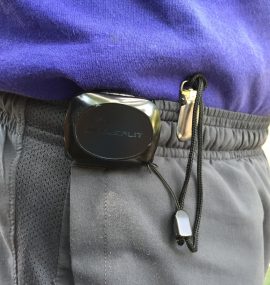What’s your level of daily physical activity?
Most people have no idea.
Lack of self-monitoring may partially account for the fact that most US adults don’t get the recommended minimum of 30 minutes of daily moderate intensity physical activity. Most US adults don’t take the recommended minimum of 10,000 daily steps, either.
Why is self-monitoring important for your health? A key maxim of the business world is ‘what gets measured gets managed.’ In other words, if you lack data about what you’re doing, it’s difficult to make conscious choices that will improve your health and well-being. If you’re like most people, your level of physical activity will increase once you start tracking it.
How can you easily get more information about how much you move around? You’ve got lots of options. A pedometer that clips to your pants band works well for the budget minded (see photo). The more gadget-minded can check out watch-type products by Fitbit, Apple Watch, and Garmin. The forgoing monitor steps, heart rate, and support various training activities.
Two years, I bought a $23 pedometer (see photo) and set a goal to walk 10,000 steps each day. In just a few days, I realized that I needed to walk more to meet my daily step goal. Thus, I increased my daily walking. The daily pedometer data motivated me to walk more. I happened to read that Dr. Martin Seligman, the father of the positive psychology movement, adopted a goal of 12,500 steps per day. He’s four years older than I am. I upped my goal to 12,500 steps per day. Thanks, Marty!
With a fitness monitor, you can check your heart rate while exercising. More specifically, you can see if your heart rate if high enough to promote aerobic fitness. To do that, your heart rate needs to be between 60-80% of your maximum heart rate. I prefer to get my heart rate to 80% of its maximum. A simple way to estimate your maximum heart rate is to subtract your age from 220. Thus, if you’re age 50, your maximum heart rate is 170 beats per minute. Eighty percent of that is 136 beats per minute. While exercising, you can check your heart rate in real time. It doesn’t take long to figure out how hard you to need to run, or jog, or walk to move your heart rate to the target level.
Getting your heart rate in the aerobic training zone every day yields big benefits. You’ll have a better circulatory system, which means you’ll have more energy to live your life. Plus, you’ll have a substantially lower risk of a heart attack, stroke, and dementia. What are you waiting for?








